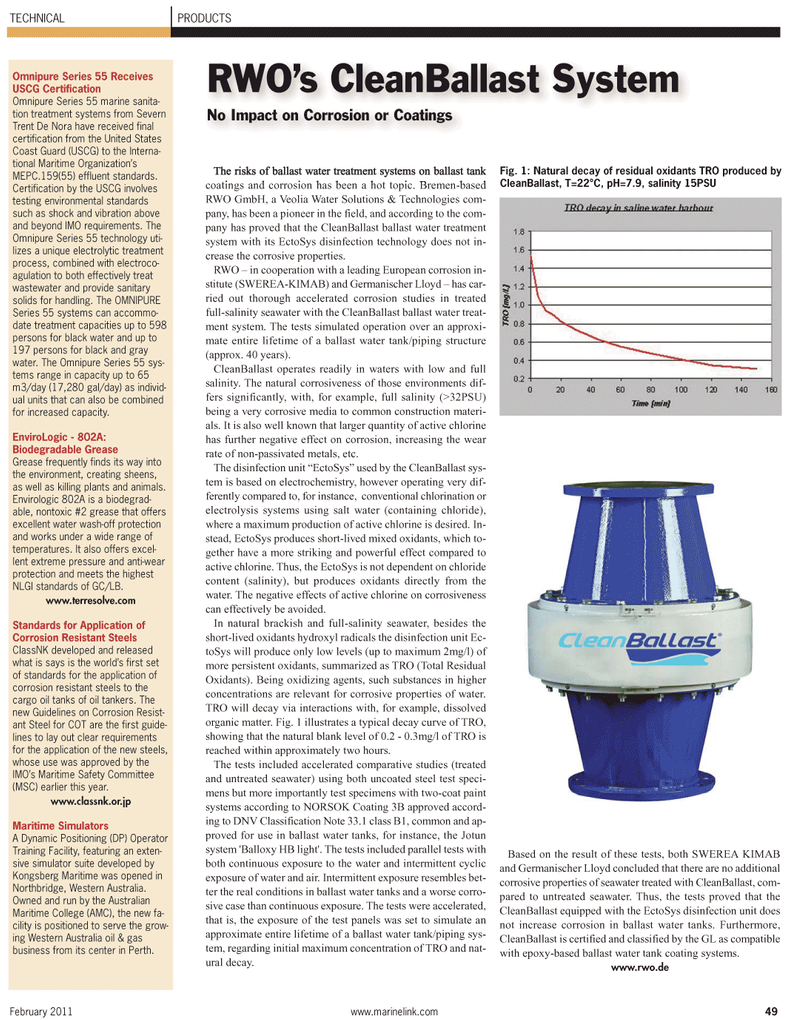
Page 49: of Maritime Reporter Magazine (February 2011)
Cruise & Passenger Vessel Annual
Read this page in Pdf, Flash or Html5 edition of February 2011 Maritime Reporter Magazine
February 2011 www.marinelink.com 49
The risks of ballast water treatment systems on ballast tank coatings and corrosion has been a hot topic. Bremen-based
RWO GmbH, a Veolia Water Solutions & Technologies com- pany, has been a pioneer in the field, and according to the com- pany has proved that the CleanBallast ballast water treatment system with its EctoSys disinfection technology does not in- crease the corrosive properties.
RWO – in cooperation with a leading European corrosion in- stitute (SWEREA-KIMAB) and Germanischer Lloyd – has car- ried out thorough accelerated corrosion studies in treated full-salinity seawater with the CleanBallast ballast water treat- ment system. The tests simulated operation over an approxi- mate entire lifetime of a ballast water tank/piping structure (approx. 40 years).
CleanBallast operates readily in waters with low and full salinity. The natural corrosiveness of those environments dif- fers significantly, with, for example, full salinity (>32PSU) being a very corrosive media to common construction materi- als. It is also well known that larger quantity of active chlorine has further negative effect on corrosion, increasing the wear rate of non-passivated metals, etc.
The disinfection unit “EctoSys” used by the CleanBallast sys- tem is based on electrochemistry, however operating very dif- ferently compared to, for instance, conventional chlorination or electrolysis systems using salt water (containing chloride), where a maximum production of active chlorine is desired. In- stead, EctoSys produces short-lived mixed oxidants, which to- gether have a more striking and powerful effect compared to active chlorine. Thus, the EctoSys is not dependent on chloride content (salinity), but produces oxidants directly from the water. The negative effects of active chlorine on corrosiveness can effectively be avoided.
In natural brackish and full-salinity seawater, besides the short-lived oxidants hydroxyl radicals the disinfection unit Ec- toSys will produce only low levels (up to maximum 2mg/l) of more persistent oxidants, summarized as TRO (Total Residual
Oxidants). Being oxidizing agents, such substances in higher concentrations are relevant for corrosive properties of water.
TRO will decay via interactions with, for example, dissolved organic matter. Fig. 1 illustrates a typical decay curve of TRO, showing that the natural blank level of 0.2 - 0.3mg/l of TRO is reached within approximately two hours.
The tests included accelerated comparative studies (treated and untreated seawater) using both uncoated steel test speci- mens but more importantly test specimens with two-coat paint systems according to NORSOK Coating 3B approved accord- ing to DNV Classification Note 33.1 class B1, common and ap- proved for use in ballast water tanks, for instance, the Jotun system 'Balloxy HB light'. The tests included parallel tests with both continuous exposure to the water and intermittent cyclic exposure of water and air. Intermittent exposure resembles bet- ter the real conditions in ballast water tanks and a worse corro- sive case than continuous exposure. The tests were accelerated, that is, the exposure of the test panels was set to simulate an approximate entire lifetime of a ballast water tank/piping sys- tem, regarding initial maximum concentration of TRO and nat- ural decay.
Based on the result of these tests, both SWEREA KIMAB and Germanischer Lloyd concluded that there are no additional corrosive properties of seawater treated with CleanBallast, com- pared to untreated seawater. Thus, the tests proved that the
CleanBallast equipped with the EctoSys disinfection unit does not increase corrosion in ballast water tanks. Furthermore,
CleanBallast is certified and classified by the GL as compatible with epoxy-based ballast water tank coating systems. www.rwo.de
TECHNICAL PRODUCTS
RWO’s CleanBallast System
No Impact on Corrosion or Coatings
Fig. 1: Natural decay of residual oxidants TRO produced by
CleanBallast, T=22°C, pH=7.9, salinity 15PSU
Omnipure Series 55 Receives
USCG Certification
Omnipure Series 55 marine sanita- tion treatment systems from Severn
Trent De Nora have received final certification from the United States
Coast Guard (USCG) to the Interna- tional Maritime Organization’s
MEPC.159(55) effluent standards.
Certification by the USCG involves testing environmental standards such as shock and vibration above and beyond IMO requirements. The
Omnipure Series 55 technology uti- lizes a unique electrolytic treatment process, combined with electroco- agulation to both effectively treat wastewater and provide sanitary solids for handling. The OMNIPURE
Series 55 systems can accommo- date treatment capacities up to 598 persons for black water and up to 197 persons for black and gray water. The Omnipure Series 55 sys- tems range in capacity up to 65 m3/day (17,280 gal/day) as individ- ual units that can also be combined for increased capacity.
EnviroLogic - 802A:
Biodegradable Grease
Grease frequently finds its way into the environment, creating sheens, as well as killing plants and animals.
Envirologic 802A is a biodegrad- able, nontoxic #2 grease that offers excellent water wash-off protection and works under a wide range of temperatures. It also offers excel- lent extreme pressure and anti-wear protection and meets the highest
NLGI standards of GC/LB. www.terresolve.com
Standards for Application of
Corrosion Resistant Steels
ClassNK developed and released what is says is the world’s first set of standards for the application of corrosion resistant steels to the cargo oil tanks of oil tankers. The new Guidelines on Corrosion Resist- ant Steel for COT are the first guide- lines to lay out clear requirements for the application of the new steels, whose use was approved by the
IMO’s Maritime Safety Committee (MSC) earlier this year. www.classnk.or.jp
Maritime Simulators
A Dynamic Positioning (DP) Operator
Training Facility, featuring an exten- sive simulator suite developed by
Kongsberg Maritime was opened in
Northbridge, Western Australia.
Owned and run by the Australian
Maritime College (AMC), the new fa- cility is positioned to serve the grow- ing Western Australia oil & gas business from its center in Perth.

 48
48

 50
50
